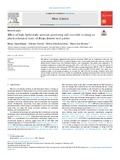Effect of high-hydrostatic pressure processing and sous-vide cooking on physicochemical traits of biceps femoris veal patties
Fecha
2022Autor
Versión
Acceso abierto / Sarbide irekia
Tipo
Artículo / Artikulua
Versión
Versión publicada / Argitaratu den bertsioa
Impacto
|
|
10.1016/j.meatsci.2022.108772
Resumen
The effects of non-thermal, high-hydrostatic-pressure processing (HPP) and its combination with sous vide cooking technique (HPP-SVCOOK) on physicochemical traits of veal patties elaborated with top sirloin caps (Biceps femoris) derived from local Pyrenean bullocks, were investigated. The patties were subjected to 13 treatment combinations of three HPP pressures (350, 475, or 600 MPa) for 5, 10, ...
[++]
The effects of non-thermal, high-hydrostatic-pressure processing (HPP) and its combination with sous vide cooking technique (HPP-SVCOOK) on physicochemical traits of veal patties elaborated with top sirloin caps (Biceps femoris) derived from local Pyrenean bullocks, were investigated. The patties were subjected to 13 treatment combinations of three HPP pressures (350, 475, or 600 MPa) for 5, 10, or 15 min, followed by 20 treatment combinations with subsequent SVCOOK at three cooking temperatures (55, 60 or 65 °C). Significant changes in color and texture parameters were observed in HPP and HPP-SVCOOK patties. Also, there was a significant effect of processing parameters on cooking loss. HPP-SVCOOK processing conditions dealt with several changes in texture and color of patties. For yielding the optimum processing results in terms of reduced hardness and cooking loss, veal patties should be HPP-treated at 350 MPa for 10 min., and sous-vide cooked at 55 °C. [--]
Materias
Cooking,
High hydrostatic pressure processing,
Meat,
Optimization,
Processing,
Sous vide
Editor
Elsevier Applied Science
Publicado en
Meat Science, 2022, 188 (),0-0
Departamento
Universidad Pública de Navarra/Nafarroako Unibertsitate Publikoa. Institute on Innovation and Sustainable Development in Food Chain - ISFOOD
Versión del editor
Entidades Financiadoras
This project has received funding from the European Union's H2020 Research and Innovation Program under the Marie Sklodowska-Curie grant (grant agreement No 801586).







